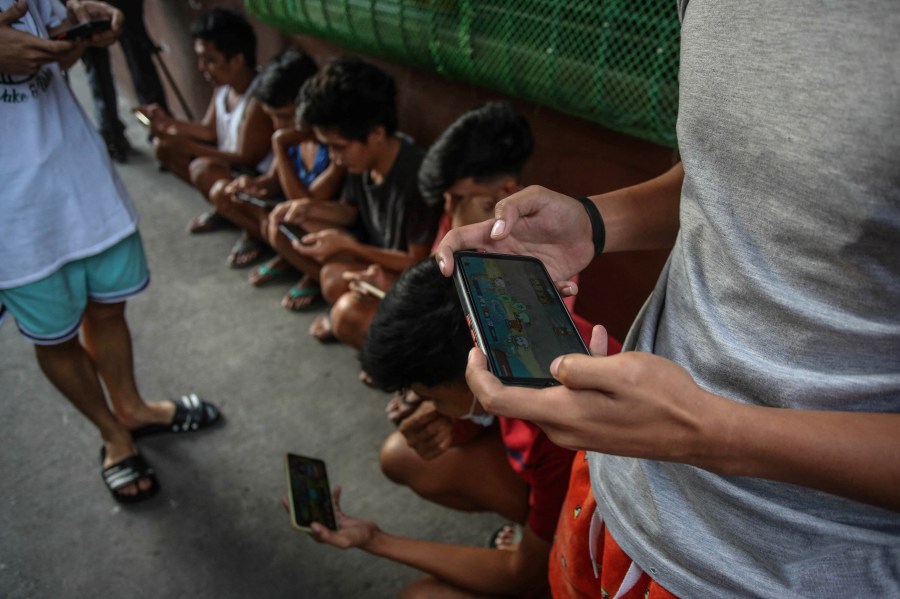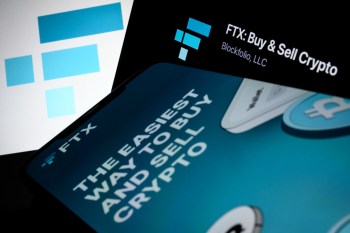Why crypto has made a comeback in the Philippines

Crypto is once again big in the Philippines.
It first took off during COVID-19 lockdowns in 2021 with a now-defunct video game called Axie Infinity, where players earned money — often more than minimum wage — through non-fungible tokens, or NFTs.
Of course, the crypto winter soon followed with the implosion of FTX in 2022, but now crypto is back in a big way on the island nation.
Marketplace’s Meghan McCarty Carino spoke with reporter Eli Tan, who recently visited and wrote about the scene for The New York Times.
The following is an edited transcript of their conversation
Eli Tan: I went to internet cafes that had popped up around Manila. It was packed every night with people coming in to play these games as their full-time income. I visited farms where real-life farmers were on their phones harvesting virtual crops to earn money that they were using to expand their farms. I talked to people who were, they’re “OFW’s.” So they’re overseas Filipino workers, and they were basically making enough money through crypto to return home to the Philippines, to their families, and they call themselves overseas metaverse workers now. So yeah, it was kind of kind of a crazy thing to witness.
Meghan McCarty Carino: Yeah, explain a little bit more about people farming cryptocurrency in these metaverse games. This is kind of the the primary way it’s come back?
Tan: Yeah. So there’s this one game called Pixels, which is really popular, which is a farming game, which is kind of replaced Axie Infinity, which was the other game. And if I can briefly explain how the games work, because it’s kind of confusing: Imagine just a normal phone game that has some kind of virtual currency. Think about, I don’t know, an Angry Birds or Candy Crush, some game where you’re earning a currency called gems or gold or diamonds or whatever it is. But what makes these games unique is that you can take that currency, and you can actually move it out of the game and sell it for, in this case, pesos or dollars, or whatever it is. So that’s kind of how the games work. So yeah, these farmers, they love this game. I talked to the founder of the game, and he said that Filipino farmers are constantly messaging him and telling him how to make the game more realistic. And they’re sending him their crop schedules and their watering routines and all sorts of stuff.
McCarty Carino: What are the factors that have made crypto so popular in the Philippines?
Tan: Well, if you look at the demographics of the Philippines, this is a country where a lot of people do not have bank accounts — nearly half of people do not own bank accounts. But almost everyone has access to the internet, and most people have phones. So it’s kind of this perfect environment for people to use crypto in a place that, I was told, the traditional banking system has kind of failed people, especially in the rural provinces where a lot of people, they weren’t born in hospitals. They don’t have ID, they can’t make bank accounts. But they can buy cryptocurrency. The other thing is that the Philippines has long been this country of first technology adopters. In the [1990s] it was the text messaging capital of the world. In the mid- to early 2000s, it was the social media capital of the world. I mean, Filipinos have always been kind of curious and at the forefront of a lot of these like technological movements, and crypto is kind of one of those things that they’ve really taken to.
In 2021, it truly looked like a crypto enthusiast’s dream. I mean, people were trading this game’s currency [in] Axie Infinity — Smooth Love Potion was the name of the currency. And people were going to the grocery stores, and to the gas stations, and just buying things in the cryptocurrency. They weren’t even having to transfer to pesos. That’s really the only time that cryptocurrency, in my view, has ever really worked for its intended purpose of being used as this currency separated from the traditional banking system.
McCarty Carino: And then there’s kind of the the economic aspect. It sounds like a lot of people there are kind of turning to crypto as a way to build wealth in an economy where it’s very hard to do so. This has kind of been a theme with crypto everywhere.
Tan: Yeah. And that also is kind of where there’s some of the concern. I mean, if you look at the economy of the Philippines, there’s not very much manufacturing power there compared to somewhere like Indonesia. It relies heavily on kind of these IT jobs, or jobs at places like call centers — a lot of them that I was told, you know, could be replaced by AI, and people are really worried about that. But I think the concern is that cryptocurrency is kind of a dangerous thing to invest in or get into, it’s very volatile. And these games are even more volatile than kind of the traditional assets you think of like bitcoin and ether. So I think while a lot of people are excited about what this new movement could bring, there’s also a lot of fear, and fear from the government, about what could go wrong as well.
McCarty Carino: Right, crypto itself is sort of risky and speculative. And then there are also the kind of scams and fraud that tend to follow.
Tan: Yeah, exactly. There’s a lot of scams, a lot of fraud, even by crypto standards in the Philippines. There are a lot of phishing scams where people trick other users into thinking there’s some kind of giveaway or some kind of gift and clicking on a link and then trying to drain their crypto wallet, or there’s this scam called pig butchering, where basically people will text or Facebook message you, pretend to be someone else that needs something and tries to scam you that way. So those two are kind of the common ones that I found that tend to prefer the use of cryptocurrency because it’s harder to trace back or reverse like you would if you’re wiring funds from a bank account.
McCarty Carino: So you write that this is all posing a bit of a conundrum for the government. I mean, clearly, there are some big risks here. But there are some benefits to this resurgence. I mean, how have officials been responding?
Tan: You know, the officials are kind of mixed on it. Most of the Securities and Exchange Commission officials declined interview requests from me, but I was able to kind of dig up a few past speech transcripts and old videos of speeches they’d given at crypto conferences. And I found that they’re really wrestling with this, because on the one hand, it could be this economic boon to an otherwise struggling economy. But then, one of the SEC commissioners basically talked about how he was actually scheduled to meet with a lot of the leadership at FTX, which is the defunct cryptocurrency exchange, on the day that they went bankrupt about expanding in the Philippines. He basically talked about, you know, “Look, that would have been a sign of economic opportunity. But if we had let more Filipinos put their money on FTX, it would have been a disaster.” So I think that they’re very conscious about it. And they’re weighing kind of what the risks are. But they’ve also said that they basically came out and said that they’re more pro-crypto than the U.S. Securities and Exchange Commission. So yeah, there’s kind of a lot of interesting aspects to it.
McCarty Carino: Does the Philippines regulate crypto markets at all right now?
Tan: It does regulate crypto markets. And in the past year, it’s kind of made this big push to push Filipinos towards the SEC-approved exchanges and companies and kind of outlaw a lot of the products that it doesn’t see as super safe. But as is with crypto, people can kind of choose to use whatever services they want.
McCarty Carino: Why do you think the Philippines is seeing this renewed interest in crypto now?
Tan: Well, a lot of it has to do with these bitcoin-approved ETFs offered from these massive financial institutions like BlackRock and Fidelity, where there’s just a lot of institutional money that’s kind of coming into the system. And it’s raising the price of coins. There’s just more money in the system to trickle down to the users and to give out as rewards. Now, because basically, players can once again earn the minimum wage or twice the minimum wage, that’s kind of what’s brought them back, whereas a few months ago, maybe they were only earning, you know, a 10th of the minimum wage.
McCarty Carino: You’ve been reporting on on crypto for a while. I’m curious what the popularity of crypto and what crypto means in a place like the Philippines. Does it sort of tell us something more broadly about the crypto universe and where it could be going and what it means?
Tan: Yeah, I mean, the interesting thing to me, I feel like years ago, in 2021, there was all this talk of the metaverse and Web3 and all these, like, really nebulous terms that crypto was going to be kind of the future of all this stuff. And venture capitalists, they put all this money into these visions, right? And it just didn’t work out. But for whatever reason, in the Philippines, it has worked out. It’s the only place that any of this stuff actually came to fruition. By the estimates of game developers, around 30% of the world’s crypto gamers are in the Philippines. It’s really the haven for this stuff. I don’t really know what that says about, like, the larger movement. I think most people at this point are pretty pessimistic about whatever Web3 is or the metaverse, but in Southeast Asia and in the Philippines, it’s very live, and it’s become the livelihoods of a lot of people.
It’s not just the Philippines that has become a hot spot for crypto — several countries in Southeast Asia have, according to Forbes.
Vietnam and Indonesia are seen as relatively crypto-friendly, and like the Philippines, have a large unbanked population and a large migrant worker population that regularly sends remittances back home.
As the piece points out, sending money internationally through traditional channels can result in high transaction fees, but with crypto, that’s not so much of an issue.
In fact, in 2023, overseas Filipino workers — that term that Eli Tan mentioned — sent back a record $37 billion in remittances.
And about 60% of those so-called OFW’s are women, who often leave their families for months or years at a time to go work abroad.
For his story, Eli Tan spoke to a former preschool teacher who now runs a crypto guild, teaching tens of thousands of members, many of them Filipinas working abroad, how to trade and invest in crypto.
He said as crypto markets have recovered, many of those women are now earning enough to return home to their families.
The future of this podcast starts with you.
Every day, the “Marketplace Tech” team demystifies the digital economy with stories that explore more than just Big Tech. We’re committed to covering topics that matter to you and the world around us, diving deep into how technology intersects with climate change, inequity, and disinformation.
As part of a nonprofit newsroom, we’re counting on listeners like you to keep this public service paywall-free and available to all.
Support “Marketplace Tech” in any amount today and become a partner in our mission.


















